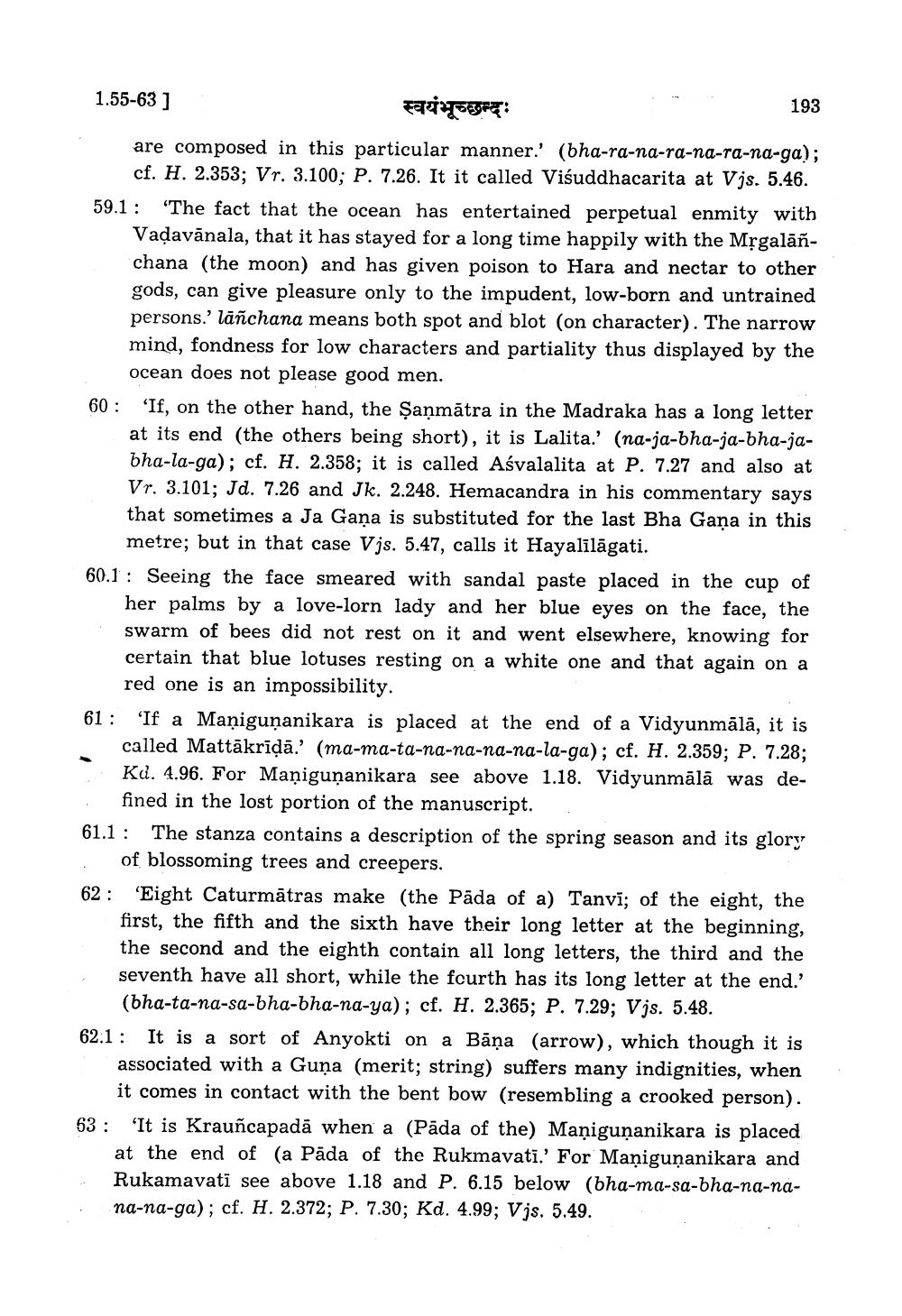________________
1.55-63 ] स्वयंभूच्छन्दः
193 are composed in this particular manner.' (bha-ra-na-ra-na-ra-na-ga);
cf. H. 2.353; Vr. 3.100; P. 7.26. It it called Visuddhacarita at Vjs. 5.46. 59.1: 'The fact that the ocean has entertained perpetual enmity with
Vadavānala, that it has stayed for a long time happily with the Mļgalāñchana (the moon) and has given poison to Hara and nectar to other gods, can give pleasure only to the impudent, low-born and untrained persons.' lāñchana means both spot and blot (on character). The narrow mind, fondness for low characters and partiality thus displayed by the
ocean does not please good men. 60 : ‘If, on the other hand, the Şaņmātra in the Madraka has a long letter
at its end (the others being short), it is Lalita.' (na-ja-bha-ja-bha-jabha-la-ga); cf. H. 2.358; it is called Asvalalita at P. 7.27 and also at Vr. 3.101; Jd. 7.26 and Jk. 2.248. Hemacandra in his commentary says that sometimes a Ja Gana is substituted for the last Bha Gana in this
metre; but in that case Vjs. 5.47, calls it Hayalīlāgati. 60.1 : Seeing the face smeared with sandal paste placed in the cup of
her palms by a love-lorn lady and her blue eyes on the face, the swarm of bees did not rest on it and went elsewhere, knowing for certain that blue lotuses resting on a white one and that again on a
red one is an impossibility. 61: 'If a Manigunanikara is placed at the end of a Vidyunmālā, it is
called Mattākrīdā.' (ma-ma-ta-na-na-na-na-la-ga); cf. H. 2.359; P. 7.28; Kd. 4.96. For Manigunanikara see above 1.18. Vidyunmālā was de
fined in the lost portion of the manuscript. 61.1: The stanza contains a description of the spring season and its glory
of blossoming trees and creepers. 62 : 'Eight Caturmātras make (the Päda of a) Tanvi; of the eight, the
first, the fifth and the sixth have their long letter at the beginning, the second and the eighth contain all long letters, the third and the seventh have all short, while the fourth has its long letter at the end.'
(bha-ta-na-sa-bha-bha-na-ya); cf. H. 2.365; P. 7.29; Vjs. 5.48. 62.1: It is a sort of Anyokti on a Bāņa (arrow), which though it is
associated with a Guņa (merit; string) suffers many indignities, when
it comes in contact with the bent bow (resembling a crooked person). 63: 'It is Krauñcapadā when a (Päda of the) Manigunanikara is placed
at the end of (a Päda of the Rukmavati.' For Manigunanikara and Rukamavati see above 1.18 and P. 6.15 below (bha-ma-sa-bha-na-nana-na-ga); cf. H. 2.372; P. 7.30; Kd. 4.99; Vjs. 5.49.
(62




